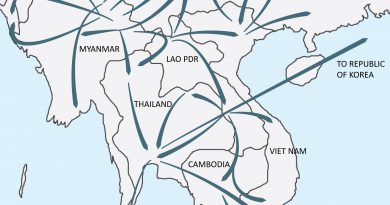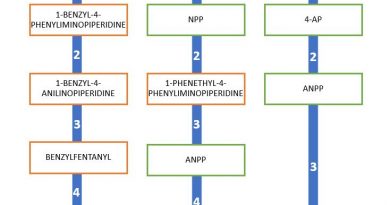UNODC EWA: Ketamine in East and Southeast Asia and Oceania on the rise
VIENNA, Austria – August 2024: Following the detection of large-scale clandestine ketamine laboratories in recent years, several countries and territories in East and Southeast Asia and Oceania reported high levels of ketamine seizures in 2023, including Australia, Myanmar, Taiwan Province of China and Thailand, pointing towards a further supply-driven market expansion.
In Australia, authorities seized a record amount of ketamine in 2023 and expressed concerns about criminals increasing their efforts to import the substance.[1] Excretion levels of ketamine in wastewater[2] in Australian capital cities increased from August to December 2023 and then further to February 2024, reaching the second-highest level recorded by the monitoring program.[3]
In East and Southeast Asia, ketamine seizures of 23.3 tons were reported in 2023.[4] Organized crime groups seem to pursue a supply-driven market expansion strategy similar to the approach adopted to expand the methamphetamine market during the past decade. Moreover, new forms of drug products containing ketamine marketed as “happy water”, “k-powdered milk” and “party lollipops” have emerged on the illicit market in recent years. These products may contain a range of different psychoactive substances in varying combinations and concentrations, with ketamine being a frequently identified ingredient. “Party lollipops” are one of the most recent synthetic drug products and are offered in attractive packaging appealing to young drug users[5] (see Photo 1).
Photo 1: Image of a “party lollipop” sample provided by the Office of the Narcotics Control Board of Thailand

Source: UNODC, Synthetic Drugs in East and Southeast Asia report 2024 (image provided by the Office of the Narcotics Control Board of Thailand).
Over the past two years, the number of “ecstasy” exhibits containing ketamine (often in combination with other substances including MDMA, methamphetamine and NPS) analysed in Singapore has been increasing. In the first six months of 2024, 50 percent of “ecstasy” seizures were found to contain ketamine as compared to 23 percent in the second half of the year in 2023 (Figure 1)[6].
Figure 1: Number of “Ecstasy” seizures containing ketamine in Singapore

Source: Health Science Authority Singapore Ecstasy Bulletin, Jan.-Jun. 2024
Apart from being found in drug products sold under other street names, ketamine has a market on its own. In New Zealand, where the use of “psychedelics” (a category which includes LSD, psilocybin and ketamine) has been on the increase over the last decade with a narrowing gender gap between male and female users [7], in 2023, 91 percent of ketamine samples collected by drug checking clinics contained ketamine as the only psychoactive substance, 3 percent contained ketamine mixed with other psychoactive substances and 6 percent did not contain ketamine. Samples that did not contain ketamine most commonly contained 3,4-methylenedioxymethamphetamine (MDMA), fluorexetamine, heroin and deschloroketamine.[8] An alert was published by the NZ Drug Foundation on fluorexetamine being sold as ketamine across New Zealand.[9]
In total, 11 out of 13 countries and territories from East and Southeast Asia and Oceania have reported ketamine in seized material to the UNODC EWA in the time period 2022-24*. Additionally, during this time period, six countries and territories from these regions have reported twelve other phencyclidine-type substances to the UNODC EWA.
In the latest UNODC Current NPS Threats report Vol. VII. (published July 2024), ketamine was among the substances most commonly reported among post-mortem, drug driving (DUID), drug use and clinical admission cases on a global level. Particularly, drug use cases (n=863) constituted the largest portion of submitted toxicology cases, almost 90 percent of which were from East and Southeast Asia.[10] Among the ketamine cases from East and Southeast Asia, ketamine was identified as the only psychoactive substance in 75 percent, while in 24 percent of cases, it was identified with stimulants such as MDMA and/or methamphetamine. A similar pattern was highlighted in the previous issue of the Current NPS Threats Report.[11]
The purpose of this early warning message is to increase awareness on a likely expansion of the supply of illicitly manufactured ketamine East and Southeast Asia and Oceania and potential consequences for persons who use drugs. Drug analysis and toxicology laboratories may consider the presence of ketamine alone or in combination with other psychoactive substances including in samples not submitted as ketamine as well as the presence of ketamine analogues. National early warning mechanisms may consider informing relevant stakeholders about a potentially increased availability of ketamine, attempts by traffickers to market drug products containing ketamine to young and unexperienced users, and the presence of ketamine in drug products not necessarily marketed as ketamine.
For more information please see:
UNODC, Current NPS Threats, Volume VII, July 2024.
————————————————————————————————————————————————————————————————-
References:
[1] Australian Federal Police, Surge in ketamine imports into Australia, press release, 3 March 2024.
[2] The term excretion (as opposed to consumption) is used for ketamine due to the absence of clear information in the scientific literature around suitable factors to estimate consumption of the substances in wastewater.
[3] Australian Criminal Intelligence Commission, National wastewater drug monitoring program. Report 22, 2024.
[4] United Nations Office on Drugs and Crime, Synthetic Drugs in East and Southeast Asia. Latest developments and challenges 2024.
[5] Ebd.
[6] Health Science Authority Singapore, Ecstasy Bulletin, Jan.-Jun. 2024.
[7] New Zealand Drug Foundation: Prevalence of psychedelic use over time by gender (2012/13 – 2022/23), 6 March 2024.
[8] New Zealand Drug Foundation: Drug checking 2023: What we found in ketamine, 27 March 2024.
[9] New Zealand Drug Foundation: Ketamine, n.d.
[10] Although the analysis allows for a broader understanding of the associated harm of NPS, it is not an exhaustive representation of the variety and toxicity of NPS present globally and regionally.



